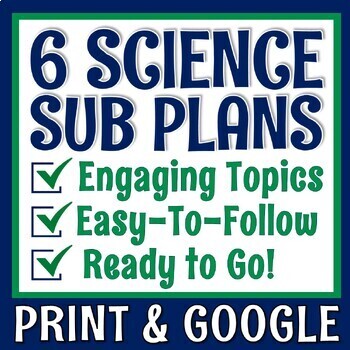Emergency High School Middle School Science Sub Plan Set Reading and Worksheet
- Zip
- Google Apps™
- Easel Activity

What educators are saying
Products in this Bundle (6)
showing 1-5 of 6 products
Description
SAVE 35% OFF LIST PRICES! Includes both PRINT and DIGITAL options! This bundle of READY-TO-GO and NO PREP science substitute plans contains 6 resources that are perfect for days when you cannot leave a more specific plan. Each includes an informative article and a corresponding worksheet that asks text-dependent questions.
These resources are PERFECT AS SUB PLANS because:
- The topics are engaging for kids and relate science topics to the real world.
- NO PRIOR KNOWLEDGE is required - all the information kids need is included in the text.
- Clear answer keys are included, making it easy for any sub to review even if they don't have subject knowledge.
- Each article supports literacy, reading comprehension, and vocabulary acquisition.
- All included lessons are linked to NGSS science standards.
- No copies needed! Digital Google Slides versions are provided for all lessons.
- Using the paper version? Spend less time at the copier! Each article is separate from the student worksheets, so you only need to make one class set of the readings. They can be reused class-class.
INCLUDED ARTICLES (All include a student worksheet with analysis questions):
✅ Health Risks in Space (NGSS MS-ESS1-1)
✅ How Might Animals be Affected by Climate Change? (NGSS MS-ESS3-5, LS2-4)
✅ The Eruption of Mt. St. Helens (NGSS MS-ESS2-2, ESS3-2)
✅ How Were Elements Named? (NGSS MS-PS1-1)
✅ Pros and Cons of Cloning (NGSS MS-LS4-5)
✅Ocean Acidification (NGSS MS-ESS3-5, LS2-4)
We also offer discipline-specific emergency science sub plans!
- Astronomy Sub Plans
- Life Science Sub Plans
- Earth Science Sub Plans
- Physical Science Sub Plans
- Or save BIG with our Sub Plans MEGA BUNDLE!
Teacher Notes:
- Please note: These PDF resources are not editable.
⭐ Let us send you TONS of FREE Grades 7-12 Science activities to try! ⭐





